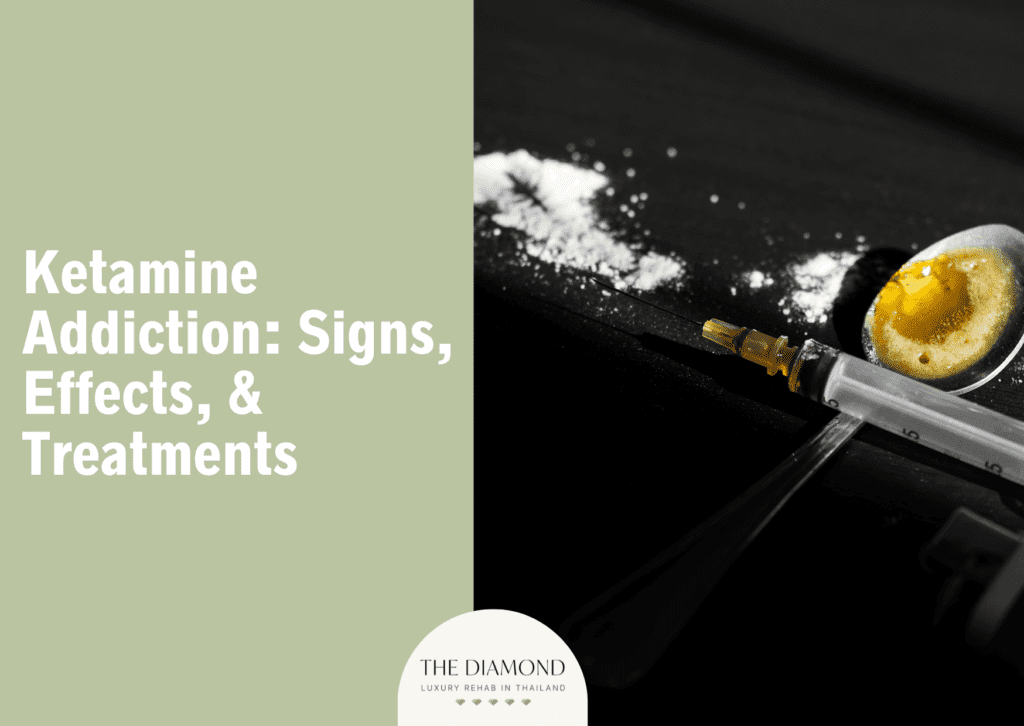Ketamine addiction: signs, effects, and treatments

Ketamine addiction is the compulsive use of this drug despite the problems it causes. People with addiction take ketamine regularly, not just in clubs. Ketamine is a dissociative anesthetic. It was first developed to act as anesthesia during medical procedures.
Today, the anesthetic use of ketamine is solely present in veterinary medicine. Ketamine is additionally used for the treatment of depression and schizophrenia. It is a powerful substance that changes one’s perception of reality and causes trance-like effects and hallucinations.
Signs of ketamine addiction are gradually increasing ketamine consumption, unsuccessful attempts to stop taking ketamine, and experiencing withdrawal symptoms and strong cravings. People spend a lot of time and money on ketamine to the point they lose interest in everything else. This leads to problems in relationships and even poor work performance.
The effects of ketamine are either short-term or long-term. Short-term effects range from a feeling of calmness to agitation, anxiety, unpleasant hallucinations, disorientation, and nausea. On the other hand, long-term effects include organ damage, severe abdominal pain, bladder and urinary tract dysfunction, overdose, dependence, and respiratory distress.
What is ketamine addiction?
Ketamine addiction is a type of physical addiction indicated by a repeated or persistent use of ketamine despite the problems and complications it causes. The American Psychiatric Association’s Diagnostic and Statistical Manual of Mental Disorders, fifth edition (DSM-5) included ketamine use disorder under the heading of phencyclidine-like substances.
Ketamine is a dissociative anesthetic with hallucinogenic effects. Back in the 1960s, ketamine was used as anesthesia in medical procedures, a 2016 paper by Linda Li and Phillip E. Vlisides in Frontiers in Human Neuroscience reported. In addition, the compound has been used for the treatment of psychotic symptoms in schizophrenia, the treatment of addiction, and the management of depression.
It probably seems ironic that a substance used to aid the addiction treatment of physical addictions is being misused. However, people misuse ketamine because it produces effects that are similar to phencyclidine (PCP). Ketamine induces trance-like effects, which is why it belongs to a group of club drugs i.e., substances that people take to enhance their experience at parties.
Since it produces an out-of-body experience, ketamine causes visual and auditory perception changes or hallucinations. The drug additionally impairs a person’s judgment, senses, and motor functions for up to 24 hours after use.
Ketamine comes in liquid form and as a white powder. Liquid ketamine is often stolen from veterinary offices because it is still used as an anesthetic by vets. People usually inject ketamine, but others snort or orally consume white powder.
What are the street names for ketamine?
Street names for ketamine refer to the colloquial or slang terms often used to conceal the substance’s identity during illicit transactions or conversations. The street names for ketamine are listed below:
- K
- Special K
- Cat Valium
- Kit Kat
- Super K
- Super Acid
- Purple
- Vitamin K
- Jet
- Jet K
- Special La Coke
- Blind Squid
- K-Ways
- K-Hold
- Kelly’s Day
- Honey Oil
- Barry Farrell
- Donkey
- Green
- Green K
- Keller
- Kitty Flip
- Super C
- Wonky
- Wobble
What are the signs of ketamine addiction?

The signs of ketamine addiction refer to the visible behavioral, psychological, and physical symptoms that point to ketamine addiction. The most common signs of ketamine addiction are listed below:
- Building tolerance i.e., need for increasing ketamine dosage to experience the same effects
- Experiencing withdrawal symptoms when attempting to stop
- Unsuccessful attempts to stop taking ketamine
- Using ketamine regularly, not just at parties from time to time
- Mixing ketamine with other addictive substances
- Spending a lot of time and money on buying, taking, and recovering from ketamine
- Continuing with ketamine use despite relationship problems, poor performance at work/school, and financial or legal difficulties
- Lack of interest in activities once enjoyed
- Repeated use of ketamine in dangerous or risky situations such as while driving
- Lying to friends and family about the extent of ketamine use
What are the possible causes of ketamine addiction?
Possible causes of ketamine addiction are unclear, but they often tend to be a combination of different factors. The possible causes of ketamine addiction are listed below:
- Genetics: Having a close family member with a history of ketamine addiction (or any substance use disorder) makes a person more susceptible to becoming addicted to ketamine as well. Certain people have a genetic predisposition to developing an addiction. A study by Francesca Ducci and David Goldman stated that addictions have a genetic component, and even one genetic variation is sufficient. In fact, genes impact every phase from the beginning to the development of addiction.
- Environment: A person’s surroundings play a role in the development of ketamine addiction. Family beliefs and attitudes, growing up in a dysfunctional home, and being exposed to ketamine (or other drugs) at home or through social circles all contribute to addiction. For example, a person who spends a lot of time with people who use ketamine is more likely to give it a try, use it recreationally, and become addicted.
- Mental health disorders: Certain mental health disorders contribute to the development of addiction. That happens because people use drugs to cope with symptoms of mental health disorders and to escape reality.
What are the side effects of ketamine?
Side effects of ketamine are undesirable reactions or unforeseen outcomes that arise from its use. The short- and long-term side effects of ketamine are listed in the table below.
| Short-term effects | Long-term effects |
| Unpleasant hallucinations | Severe abdominal pain |
| The feeling of calmness and relaxation | Kidney problems |
| Drowsiness | Bladder and urinary tract dysfunction |
| Disorientation and general confusion | Lack of cognitive ability |
| Increased heart rate | Depression |
| Elevated blood pressure | Delusional thoughts |
| Nausea | Damage to the digestive tract and the brain |
| Aggressiveness | Respiratory distress |
| Difficulty thinking | Seizures |
| Decreased awareness of the environment | Overdose |
| Forgetfulness | Physical tolerance and dependence |
| Double vision and/or involuntary eye movements | Damage to veins, muscles, and skin (when injected) |
| Irregular heartbeat | Attention deficits and decreased sociability |
How is Ketamine addiction being diagnosed?

Ketamine addiction is diagnosed similarly to other types of substance use disorders. The healthcare provider performs a physical exam, orders lab tests, and evaluates a patient’s medical history. The main purpose of a physical exam is to rule out the physical causes behind symptoms.
The healthcare provider refers a patient to a psychiatrist who performs a psychiatric evaluation. During this process, a patient answers questions about their symptoms, moods, and behaviors. A psychiatrist further talks with family or close friends of a patient to get a better insight into their behavior and mood patterns.
They want to make sure the symptoms a patient experiences aren’t due to other problems, such as schizophrenia, since it causes hallucinations and delusions as well.
Based on the information provided, especially when patients report ketamine use, a healthcare professional determines whether ketamine use disorder is the problem. They are going to consult the DSM-5 to see whether a patient meets the diagnostic criteria for this type of addiction.
Generally speaking, a patient needs to meet at least two criteria within 12 months. These include taking the drug in larger amounts and having a persistent desire or craving for ketamine. Other criteria include spending a lot of time using or buying the drug, lack of interest, and withdrawal symptoms when attempting to stop.
What are the ketamine addiction statistics?
Ketamine addiction statistics are scarce. A 2021 study by Palamar et al., published in the American Journal of Public Health showed that less than 1% of people in the United States use ketamine.
That being said, the recreational use of ketamine has increased over the last few years. The rise in the recreational use of ketamine started in 2019, which is exactly when the Food and Drug Administration (FDA) approved the use of a nasal spray version of the drug for treatment-resistant depression.
The same report showed that poisonings with ketamine were at their highest in 2000 and 2001. After this period, poisonings declined and increased again in 2014. That year, there were 1.1 poisonings per 1,000,000 people.
As per an article titled, “Ketamine Abuse Signs, Symptoms, Side Effects, and Addiction Treatment” last updated in June 2023 by the American Addiction Centers, data from the Substance Abuse and Mental Health Services Administration (SAMHSA) showed that 41,000 individuals aged 12 to 17 disclosed ketamine use at least once during 2013.
A further 540,000 individuals between the ages of 18 and 25 reported using ketamine at a certain point, according to SAMHSA data.
What are the ketamine withdrawal symptoms?

Ketamine withdrawal symptoms are physical and psychological reactions to the cessation of drug use. The most common ketamine withdrawal symptoms are listed below:
- Cravings for ketamine
- Mood swings
- Anxiety and/or depression
- Sweating
- Elevated body temperature
- Agitation
- Nausea
- Confusion
- Fatigue
- Hearing loss
- Rage
- Decreased motor skills
- Psychosis including hallucinations and delusions
- Insomnia
- Shakes
- Cognitive impairment
- Reduction in cardiac and respiratory functions
What are the treatments available for Ketamine addiction?
Treatments available for ketamine addiction refer to the range of methods and strategies utilized to assist people who are abusing the potent dissociative anesthetic ketamine. Treatments available for ketamine addiction are listed below:
- Detox: This is the first stage of the treatment process. Detoxification refers to the cessation of drug use. That is when withdrawal symptoms ensue. Detox must be performed with medical supervision in order to ensure safety. Patients often receive medications that reduce cravings and decrease the intensity of withdrawal symptoms.
- Inpatient program: Otherwise known as a residential program, it is suitable for people with moderate to severe ketamine addiction. The inpatient program involves living in a rehab center for a specific period, such as 30, 60, or 90 days. During the program, patients receive different forms of therapy, including individual therapy, family therapy, and group therapy. Different types of behavioral therapy are available, but the most effective approach is cognitive-behavioral therapy (CBT). The main goal of therapy is to help patients uncover irrational and negative thoughts that lead to negative feelings and risky behaviors. Once a patient identifies these thought patterns, they start replacing them with more positive and realistic alternatives. Therapy additionally helps people with ketamine addiction adopt coping and other skills that help them recover and prevent relapse. Besides CBT, other behavioral therapies for ketamine addiction include dialectical behavior therapy (DBT) for mindful awareness and stress management, as well as acceptance and commitment therapy (ACT) that emphasizes commitment and behavior change.
- Outpatient program: This approach is suitable for people with mild to moderate addiction. During an outpatient program, a patient doesn’t sleep in a rehab center. They just attend therapy sessions while maintaining their employment or returning home afterwards. The outpatient program consists of therapy in an individual or group setting. People who have completed inpatient treatment typically start with an outpatient program to support their recovery.


